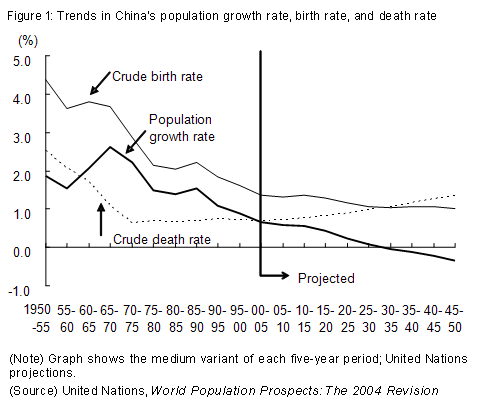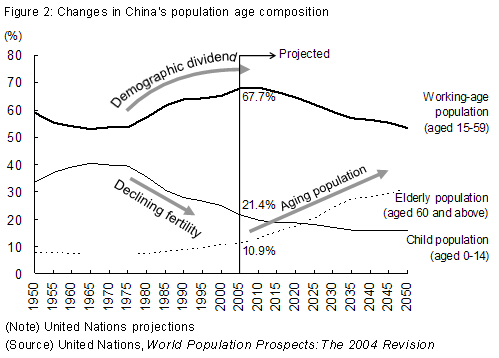"A large population and underdevelopment are the two facts China has to face. Since China has 1.3 billion people, any small individual problem multiplied by 1.3 billion becomes a big problem, and any considerable amount of financial and material resources divided by 1.3 billion becomes a very low per capita level. This is a reality that the Chinese leaders have to keep firmly in mind at all times." - Chinese Premier Wen Jiabao, in a speech delivered at Harvard University on December 10, 2003
Family planning policies were introduced in China in the first half of the 1970s with a view to curb population growth, and as part of the scheme the one-child policy was implemented in the early 1980s (box). This, together with a decline in infant mortality rate and a rise in life expectancy, has led to China making a demographic transition from the developing-country model of high birth rate, high death rate and high population growth to the developed-country model of low birth rate, low death rate and low population growth in a relatively short time (figure 1). During this transition period, the child population began falling before the graying of society, thereby leading to a rise in the working-age proportion of the population and a decline in the percentage of dependents, bringing about a "demographic dividend " that was advantageous to economic growth. However, more recently, China is beginning to hear the footsteps of an aging society, and the time is drawing near when the working-age population ratio starts to fall and the dependency ratio begins to increase. Population aging is a phenomenon generally seen in developed countries, but China will have to face the challenge of entering this stage before becoming affluent.
Triggered by the introduction of family planning policies, between the latter half of the 1960s and the first half of the 2000s, China's crude birth rate and population growth rate have decreased to 1.36% and 0.65% from 3.66% and 2.61% respectively. As a result, not only has growth in population been curbed, its age composition has also changed dramatically (figure 2). When we look at the three categories of child population (those aged 14 and younger), working-age population (aged 15-59) and elderly population (aged 60 and above), the percentage of the population who are children, which was 35.5% in 1980, fell to 21.4% in 2005. On the other hand, the percentage of the population that fell into the elderly bracket rose to 10.9% from 7.4%. Reflecting the fact that the drop in the child population was greater than the increase in the elderly population, the percentage of working-age population grew to 67.7% from 57.1%. As a result, the dependency ratio (the sum of the child and elderly populations/the working-age population) fell to 0.48 from 0.75.
However, the pace of aging in China is expected to accelerate, and the United Nations estimates that the population aged 60 or above will rise to 17.1% in 2020 and to 24.0% in 2030. Taking into consideration the fact that the decline in the child population is expected to slacken, the percentage of the working-age population will start to fall after peaking around 2010, and the dependency ratio will begin to rise. Also, while China's overall population is forecasted to start decreasing from around 2030, growth in the working-age population is estimated to start logging negative figures earlier than that - around 2015.
An aging population restricts growth
China's changing population structure may restrict the country's economic growth in two ways. First, a decline in the working-age population signifies a decrease in the labor force. The recent upward pressure on wages in coastal regions due to a decline in the supply of migrant workers (especially young workers) is a sign of this. Labor productivity must be improved if high growth is to be maintained amid such an environment. Moreover, the rise in the dependency ratio is highly likely to lead to a fall in savings rates. Because this decline means a decrease in the funds that can be used for investment, this factor will probably indirectly stunt economic growth. Furthermore, China needs to properly establish a pension system as soon as possible to prepare for an aging society.
As this shows, the harmful effects of the one-child policy are expected to surface in the form of reduced growth in the labor force and a decline in savings rates. Especially, with the complete disappearance of the demographic dividend around 2015, China's era of high economic growth that began in the late 1970s will likely come to an end. In this sense, the next decade may be China's last chance to join the ranks of developed countries.
Box: The realities of the one-child policy
Concerning China's family planning policies, the Law on Population and Family Planning adopted in 2001 stipulates that "the state seeks to stabilize the current family planning policies and encourages the people to marry and have children later in life and proposes that each married couple have one child. In the event conditions stipulated by law are met, a couple can seek permission to have a second child." In fact, in rural areas a second child is allowed if the first child is female, and the restrictions are looser for ethnic minorities than the Han. Also, in some areas such as Shanghai, couples are now becoming allowed to have a second child if both the mother and father are themselves the only child of their parents. According to Yu Xuejun, director-general of the Department of Policy and Legislation at the National Population and Family Planning Commission, the one-child policy is applied to roughly 37.8% of the total population, while 53.04% have been allowed to have a second child in the event the firstborn was a daughter. About 5.45% can have a second child regardless of the gender of their first child, while roughly 3.71% of the total population can have three or more children ("Hitorikko saisaku no seika to tenbou" [The results and prospects of the one-child policy] in Chuugoku, jinkou mondai no ima [China, the state of its population problems], written and edited by Keiko Wakabayashi, Minerva Publishing Co., 2006). |




